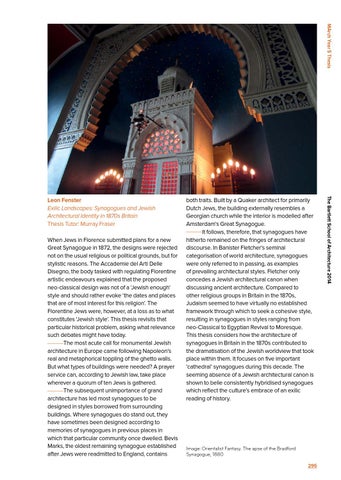MArch Year 5 Thesis
When Jews in Florence submitted plans for a new Great Synagogue in 1872, the designs were rejected not on the usual religious or political grounds, but for stylistic reasons. The Accademie del Arti Delle Disegno, the body tasked with regulating Florentine artistic endeavours explained that the proposed neo-classical design was not of a ‘Jewish enough’ style and should rather evoke ‘the dates and places that are of most interest for this religion’. The Florentine Jews were, however, at a loss as to what constitutes ‘Jewish style’. This thesis revisits that particular historical problem, asking what relevance such debates might have today. The most acute call for monumental Jewish architecture in Europe came following Napoleon’s real and metaphorical toppling of the ghetto walls. But what types of buildings were needed? A prayer service can, according to Jewish law, take place wherever a quorum of ten Jews is gathered. The subsequent unimportance of grand architecture has led most synagogues to be designed in styles borrowed from surrounding buildings. Where synagogues do stand out, they have sometimes been designed according to memories of synagogues in previous places in which that particular community once dwelled. Bevis Marks, the oldest remaining synagogue established after Jews were readmitted to England, contains
both traits. Built by a Quaker architect for primarily Dutch Jews, the building externally resembles a Georgian church while the interior is modelled after Amsterdam’s Great Synagogue. It follows, therefore, that synagogues have hitherto remained on the fringes of architectural discourse. In Banister Fletcher’s seminal categorisation of world architecture, synagogues were only referred to in passing, as examples of prevailing architectural styles. Fletcher only concedes a Jewish architectural canon when discussing ancient architecture. Compared to other religious groups in Britain in the 1870s, Judaism seemed to have virtually no established framework through which to seek a cohesive style, resulting in synagogues in styles ranging from neo-Classical to Egyptian Revival to Moresque. This thesis considers how the architecture of synagogues in Britain in the 1870s contributed to the dramatisation of the Jewish worldview that took place within them. It focuses on five important ‘cathedral’ synagogues during this decade. The seeming absence of a Jewish architectural canon is shown to belie consistently hybridised synagogues which reflect the culture’s embrace of an exilic reading of history.
Image: Orientalist Fantasy. The apse of the Bradford Synagogue, 1880 295
The Bartlett School of Architecture 2014
Leon Fenster Exilic Landscapes: Synagogues and Jewish Architectural Identity in 1870s Britain Thesis Tutor: Murray Fraser
